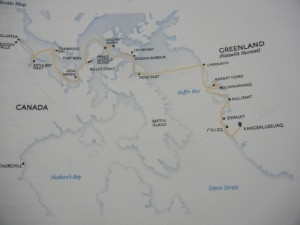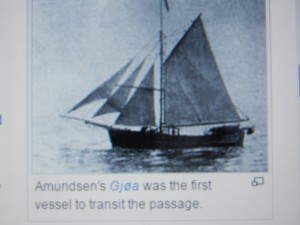It’s time again to make some plans
to visit another far off land.
Maybe a place not seen before,
a long way off on a distant shore.
I could go east, or I could go west;
I wonder which would be the best,
but then again I may go north
just to see what may bring forth.
I have crossed the Arctic circle
off Norway’s northern shore,
and braved the arctic breezes
from Alaska’s northern seas,
and I have been from east to west
across Siberian plains,
but I need a bit more north-ing
to flow into my veins.
So I thought about the passage,
you know- ‘The Northwest Passage’
where Franklin met his fate.
A place I’ve yearned to visit,
for many years of late.
It turns out now its possible
to emulate this feat with others
of like mind upon a modern ship.
The planning is in the early days,
as I tie up all loose ends,
but it looks like its a goer
and the plan we’ll come to see,
and what an awesome venture
that this will surely be.
– Neale
Frances and I are planning a trip from Greenland to Edmonton in Canada, via The Northwest Passage in August 2015 on ‘MS Sea Adventurer’.

A brief History:
In 1984 the commercial passenger vessel, MS Explorer, was the first cruise ship to navigate the Northwest Passage.
The first recorded attempt to discover the Northwest Passage was the east-west voyage of John Cabot in 1497, sent by Henry VII in search of a direct route to the Orient. There were a dozen other expeditions that followed during the 16th and 17th century. More expeditions in the 18th century, including one by Captain James Cook in 1788, failed to find a passage. In the 19th century many expeditions, including one by Sir John Franklin, on land and sea, found and charted some areas for a possible passage.
In 1845 a lavishly equipped two-shipped expedition led by Sir John Franklin sailed to the Canadian Arctic to chart the unknown areas of the Northwest Passage. They sailed fully confident with only 500 km of coast still to chart. The ships failed to return. Relief expeditions were sent over the next century and a half and many artifacts, records, notes and remains were found.
Franklin had died in 1847 and Captain Crozier had taken command. The ships became fast in ice. The decision was made to abandon ship and the men made their way south across the tundra by sledge. All were lost. Some of the crew may not have died until the early 1850’s. No evidence has been found of any survivors. Starvation. exposure and scurvy all contributed to the deaths. Later examination of three bodies exhumed from permafrost on Beechey Island revealed high concentrations of lead in all three. (the expedition carried 8,000 tins of food sealed with lead-based solder) Oh dear
Exploration continued for the remainder of the century and a route was discovered, when in 1854, Sir Edward Belcher made a transit of the Northwest Passage albeit by ship and by sledge over the ice, becoming the first people to circumnavigate the Americas.
The first explorer to conquer the passage solely by boat was the Norwegian explorer Roanld Amundsen. It was a three year journey between 1903 and 1906 in a small boat with 6 men. He figured he would have to live off the land and a small crew would be easier to feed. . He spent almost two years stuck in ice at King William Island. Although he had achieved a traversing of the passage, the route was not suitable for commercial use, because many of the waterways were only 3 feet deep.
Canadian Henry Larson was the second person to sail the passage, leaving Vancouver 23 June 1940 and arriving Halifax on 11 October 1942. (28 months) He made the return trip from Halifax to Vancouver in 1944 in a greatly reduced time of 86 days. This made him the first to traverse the passage in one season. He used a more northerly, and partly uncharted route for his second crossing.
It would take another 50 years before the passage was really open for business so to speak . Now with satellite mapping of ice flows, better charted waters, climate warming and high tek navigation make this adventure safer and less challenging.
15 Feb 2015

This is the route we will be sailing. The 20 day adventure departs from Itilleq in Greenland and arrives in Kugluktuk (Copper Mine) in Canada. Cruise departs August 18, 2015. We will leave home on July 20 travelling via Hong Kong, Paris, Prague, Berlin, Hamburg and Copenhagen to catch a charter flight to Kangerlussuaq, Greenland, just 37 miles north of the Arctic Circle where we transfer to the ‘Sea Adventurer’. We will return via Edmonton, Vancouver and Hawaii. Round the World in 58 Days.

Have followed your adventures with great envy. The Northwest passage will be a wonderful trip. My daughter-in-law’s great uncle was Thomas Manning, known as the Lone Wolf of Arctic – left a large amount of money to Cambridge University towards the Shackleton Library at the Scott Polar Research Institute – he also remembered my daughter-in-law with some as well. I look forward to August 2015. Carpe Diem